
The people's game
Jeux
Mah-Jongg
There are two versions of winning hands in the People's Game: the Simple version and the Classical version.
The Simple Version
The formation of tiles of the winning hands of the Simple version is simple and logical.
Players can totally relax and enjoy playing the game without worrying about the complex winning pattern of the Classical game.
At the same time the game provides plenty of challenges, as there will be many winning probabilities for a ready hand.
A Winning Hand
A winning hand consists of 14 tiles of any combination of Pair, Pung and Gong. These is no Sequence set of tiles in the Simple version.
Pair : two matching tiles of any Number, any suit and any tile
Pung : three matching tiles of any Number, any suit and any tile
Gong : four matching tiles of any Number, any suit and any tile
When a player holds a Pair or a Triplet, he or she may claim the identical tile discarded by any other player to match a Triplet, Gong and so forth.
The player then reveals the set on the table, then discards an unwanted tile to maintain a 13-tile hand. A player cannot claim the identical tile to match a Pair unless it is the winning tile.
When a player draws the fourth identical tile, he or she may add it to a revealed or concealed Triplet or to matches a concealed Kong (or two Pairs) In the Simple version, a player should not draw a make-up tile from the end of the wall after completing a Gong, but should just discard an unwanted tile from the playing hand, always maintain 14 tiles in a winning hand.
Formation of Tiles of Winning Hands


Scoring
| Common tiles |
Honor tiles and Flowers |
| Pair : 10 Points Pung : 20 Points Gong : 40 Points |
Pair : 20 Points Pung : 40 Points Gong : 80 Points |
Example of Standard Winning Hands and Scores
The total score of
the winning hand is the cumulative winning points in the combination of tiles of
the hand.
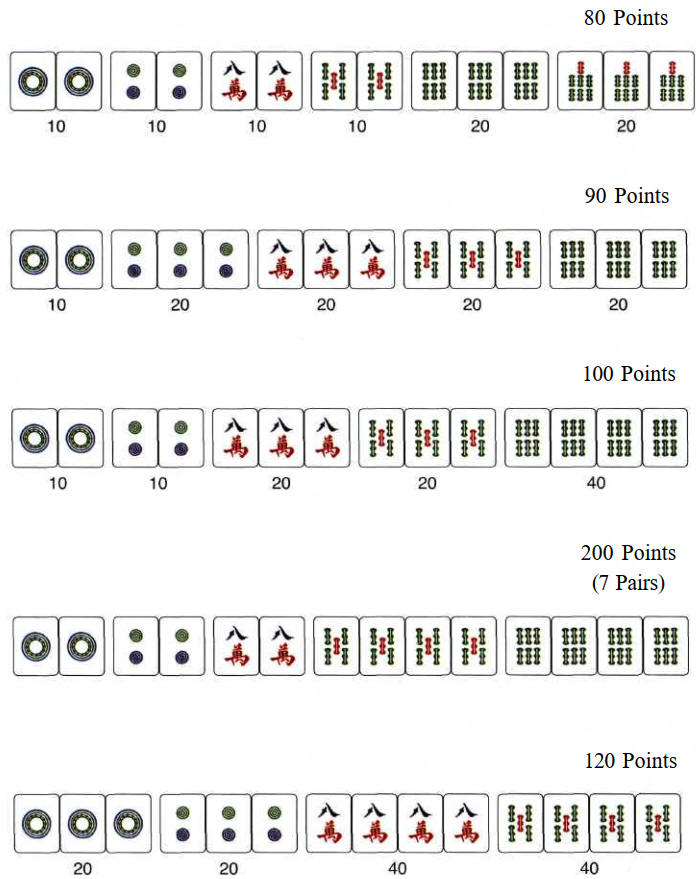
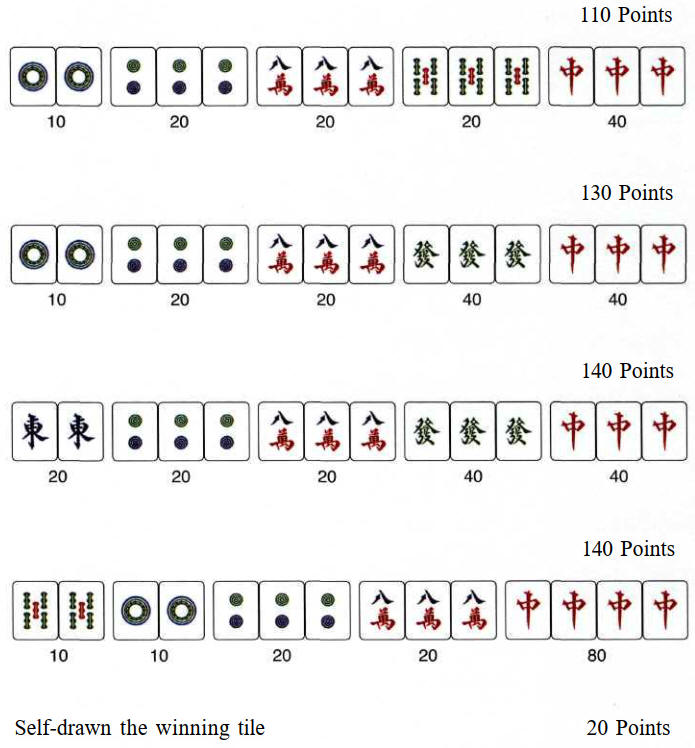
Special Winning Hand 200 Points
All odd numbers hand
All
even numbers hand
All Terminal hand
All Honors (or Flowers) hand
All
concealed hand
Only one suit hand
Only two numbers hand
Seven Pairs
hand
Three Gongs hand
Player's Variation
Players may want to add some variations to
allow the game to offer different challenges. For example, if the game is being
played on July 4, each Triplet of Number 4 or Number 7 adds 10 extra points, and
both Triplets of 4 and 7 add 40 points, and so on.
Playing the Winners
(1) The discarder of the winning tile pays all winners (more than one
winner).
(2) When a player self-draws the winning tile, all players pay
the winner.
Winning Probabilities
Ready to win hand, including revealed and
concealed sets Winning Tile Any one of the tiles
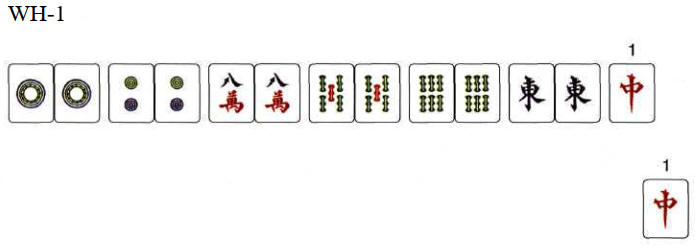

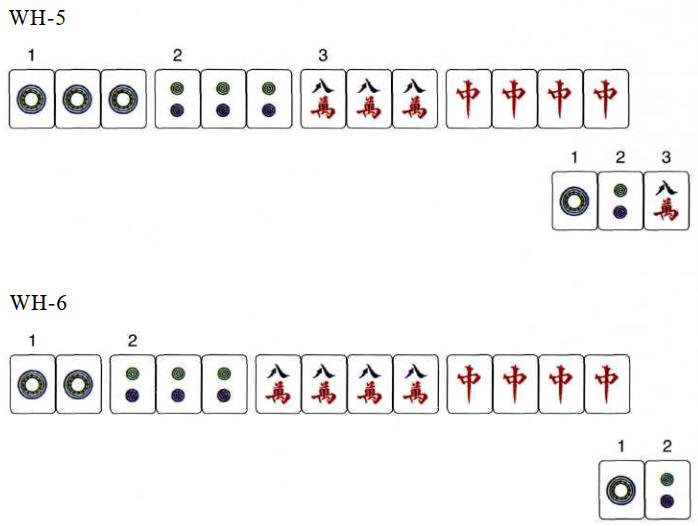
The exiting moment of the game is when a player holds a ready hand and is waiting for the final winning tile.
He or she must recognize and remember all the winning probabilities of the ready hand and try not to miss any one of the winning tiles discarded by the other players in a fast moving game.
If a player fails to claim (or intends not to claim the discard in order to wait for a self-drawn to triple his score) a discard to declare a win, he or she is not permitted to re-claim it after the next player has made a discard.
He or she is also not permitted to claim the same or other winning tile subsequently discarded by the next players until the next round of discard.
However, the player is permitted to declare a win if he or she subsequently draws the winning tile from the wall.
Falsely Declaring a Win
If a player declares a false win and
displays the winning hand on the table:
(1) If the final tile was a discard, the player pays the discarder 100 points and other players 50 points.
(2) If the final tile was self-drawn, the player must pay all players 100 points.
Players should examine the winning hand carefully before displaying it on the
table.
Miscellaneous
Penalties
Falsely Declaring a Win (Jar
Woo)
If a player declares a win by claiming a discarded tile or by
drawing a tile, and it turns out that his hand is not yet ready for the win,
then the win has been falsely declared. In this case, he or she must pay each of
the other three players an amount equivalent to four Fans.
Long and Short Hand - a playing hand is either more or
less than 13 tiles
Long or Short Hand (Dai Sheong Kung, Siu Sheong
Kung)
If, during a game, a player finds that his or her playing hand
is either more, or less, than 13 tiles, the player is not allowed to discard the
excessive tile or to draw a make-up tile to complete the hand. Instead, he or
she must continue to play by drawing and discarding tiles as usual until the
game is over.
This player must be careful in discarding tiles. To avoid losing to a high-scoring hand, he or she should discard only nonmatching tiles to other players, in the hope that no opponent will win the game by claiming one of the discards.
Fortune Hand - a Draw (Wong Pai)
When only seven stacks (14 tiles) are left on the wall, with none of the players being able to complete a winning hand, the game is considered a draw. This is called a Fortune Hand because there is no loser. The same Dealer will continue for the next game.
Playing with Flower Tiles (Dar Far)
In addition to the 136 basic tiles, a set of mahjongg also contains 8 Flower Tiles, comprising two sets of 4 tiles. The 4 tiles in one set represent the four seasons, while the 4 tiles in the other set represent the blossoms or plants of the 4 seasons.
| Set One | Set Two |
 No. 1: Spring No. 2: Summer No. 3: Autumn No. 4: Winter |
 No. 1: Plum No. 2: Orchid No. 3: Chrysanthemum No. 4: Bamboo |
Playing with the Flower tiles is optional. Flower tiles score additional Fans
for the winning hand.
When building the walls, the Flower tiles are mixed
with the other tiles. Each player will then stack up a row of 18 pairs of tiles
instead of 17 pairs. A playing hand still contains 13 tiles, however.
After the initial 13 tiles are drawn from the walls, each player reveals all the Flower tiles contained in the initial selection by placing them face up on the table.
Then the exchange process begins. Starting with the Dealer, each player in turn draws a make-up tile from the end of the wall for each revealed Flower tile.
If the make-up tile happens to be another Flower tile, the player immediately draws another make-up tile from the end of the wall. (In the 16-Tile Game, the player must wait until all the other players have drawn their make-up tiles in their normal turns.)
Similarly, during the course of the game, when a player draws a Flower tile from the wall, he or she reveals it and immediately draws a make-up tile from the end of the wall.
At no time is a Flower tile allowed to be kept in a playing hand. Moreover, if the player forgets to draw a make-up tile to replace the revealed Flower tile, he or she is not permitted to draw a make-up tile after a discard has been made.
In that case, the hand will be a tile short, known as a Short Hand (see above). The player is therefore unable to complete his or her hand to win the game.
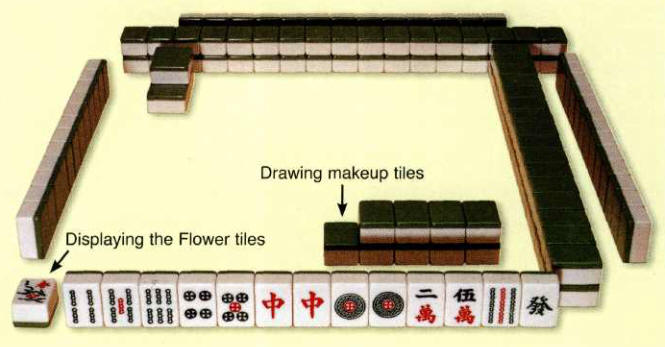
Scoring for Flower
Tiles Each Flower tile adds a Fan to the winning hand. Nevertheless, the players should agree upon the method of counting Fans and scoring prior to starting the game.
The following are the common methods of scoring Flower tiles:
A. The possession of each Flower tile, or the absence of Flower tiles, is counted as one Fan.
B. The possession of any of the Flower tiles that matches the round of game is counted as one Fan. Flower tiles that match the round of the game:
No. 1: Flower tiles during the first round (East Round).
No. 2: Flower tiles during the second round (South Round).
No. 3: Flower tiles during the third round (West Round).
No. 4: Flower tiles during the fourth round (North Round).
C. The possession of any of the Flower tiles that matches the respective position of the player is counted as one Fan. Flower tiles that match the respective position of the players:
No. 1: Flower tiles in the hand of the Dealer.
No. 2: Flower tiles in the hand of the Dealer's Lower House.
No. 3: Flower tiles in the hand of the Dealer's Opposite House.
No. 4: Flower tiles in the hand of the Dealer's Upper House.
D. The possession of any of the Flower tiles that matches both the round of the game and the respective position of the players is counted as two Fans.
No. 1: Flower tiles in the hand of the Dealer during the first round,
No. 2: Flower tiles in the hand of the Dealer's Lower House (the South House) during the second round of the game, and so on.
Any player who accumulates all eight Flower tiles during the game, is considered to have completed his or her hand and thus wins the game.
Note: When a player has accumulated seven Flower tiles, he or she can claim the eighth Flower tile previously or subsequently drawn from the walls from any player to win the game. The drawer of the eighth Flower tile is considered the discarder of the Winning Tile.
Five-Player Game - Dreaming (Dar Mung)
Mah jongg is normally a four-player game, but five players can play it by rotation. During the allotment of seats at the beginning of the game, a No. 5 Circle tile is added to the four Wind tiles to make a five-tile stack.
The four players who pick the Wind tiles will start the game.
The person who picks the No. 5 Circle tile must wait an entire round before he or she can participate. Since the fifth player has little to do, he or she is aptly called a Dreamer.
At the end of the first round (East Wind Round), the First Dealer retires and is replaced by the fifth player, the Dreamer. The retired First Dealer becomes a Dreamer for the second round.
At the end of this round (South Wind Round), the South player is replaced by the First Dealer. The game continues until five rounds have been reached, with each player having participated in four of the five. If desired, the game can continue uninterrupted by repeating the same procedure.
The seat reallotment is not required after each five-round cycle.
Three-Player Game (Dar Sam Yan Pai)
The game can be played as well in the absence of one player, by removing any one suit of the tiles from the set.
However, when casting the dice to designate the First
Dealer and to break the walls in each game, if the count ends at the absentee
player, the dice must be cast again.
Have fun!
Classical Version
A winning hand consists of 14 tiles comprised of four sets of three tiles
(Sequence and Triplet) and one Pair. For each Gong add one extra tile.
Scoring
Scoring is based on the combination and the probability of
matching of tiles in a winning hand.
Basic Hands
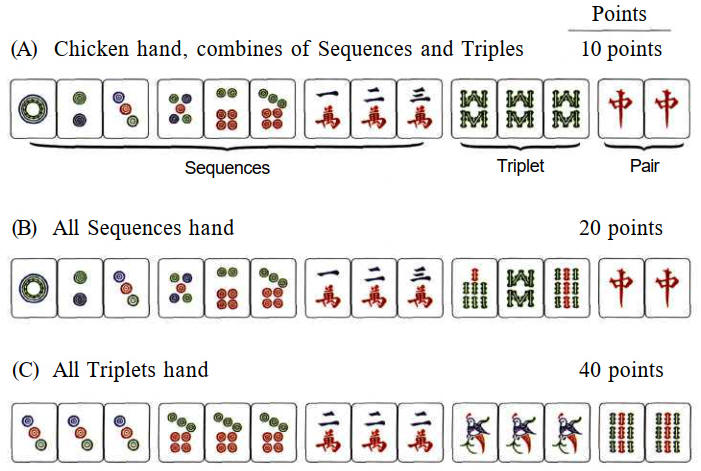
Plus certain combination of tiles will add extra points to a winning hand.
Dragon and Wind Tiles


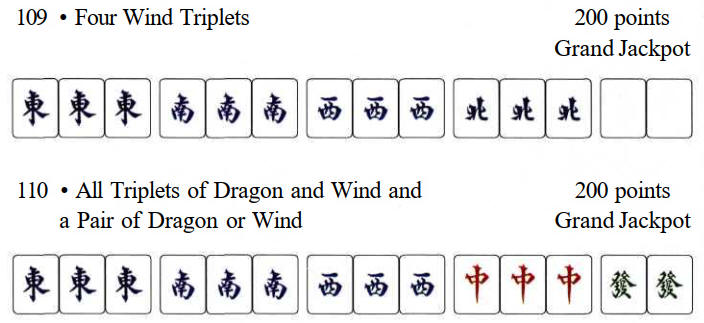
Other Combinations

114 • The Heaven Hand : 200 points The winning tile is the first tile self-drawn Grand Jackpot by the dealer.
115 • The Earth Hand 200 points The winning tile is the first tile discarded Grand Jackpot by the dealer.
116 • The winning tile is the last tile pick up 50 points from the wall.
117 • Self-drawn winning tile 10 points
118 • Robbing the Gong 10 points
The winning tile is the fourth identical tile when a player adds to his or her revealed Triplet and declares a Gong. The Gong player pays winner.
119 • Win on Gong 20 points
The winning tile is the make-up tile drawn from the end of the wall right after a player declares a Gong
(a) The discarder of the 4th identical tile pays for all players.
(b) All players pay the winner when the 4th identical tile is self-drawn.
120 • Consecutive Gong 100 points
When a player claims or draws the 4th identical tile Jackpot to declare a Gong and the make-up tile he or she draws from the end of the wall is also an identical tile of another revealed or concealed Triplet, the player declares a Gong again, and if the second make-up tile he or she draws from the end of the wall happens to be the winning tile:
(a) The discarder of the first Gong pays winner for all players.
(b) When the player draws the 4th identical tile for the first Gong, all players pay winner.
Sequences Combinations


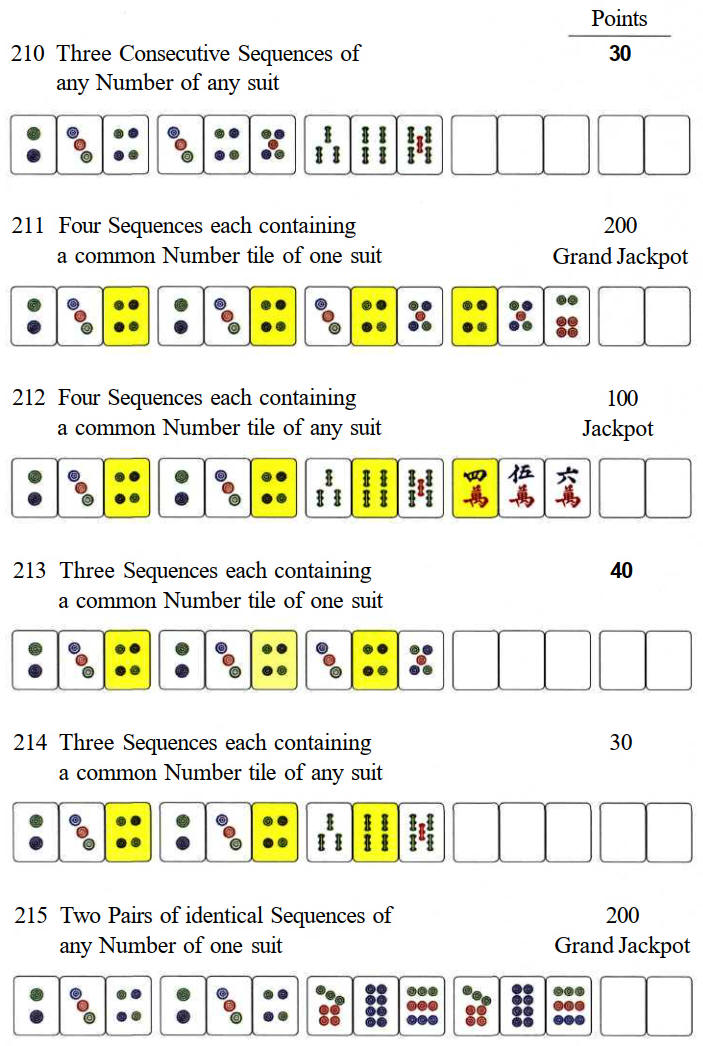
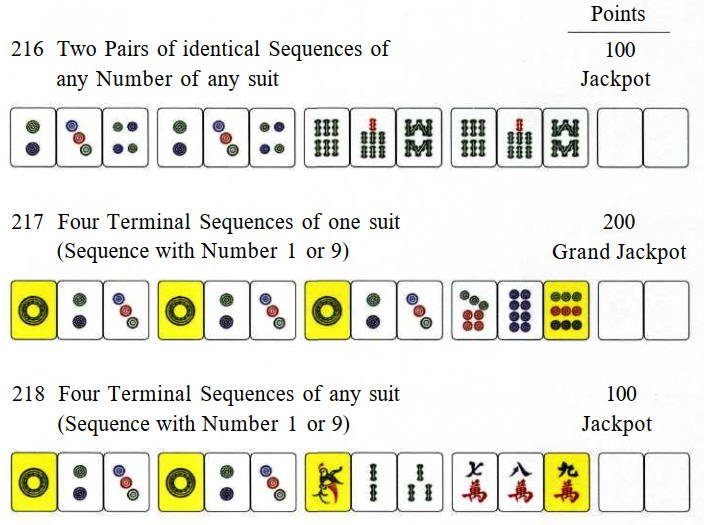
Triplets Combinations

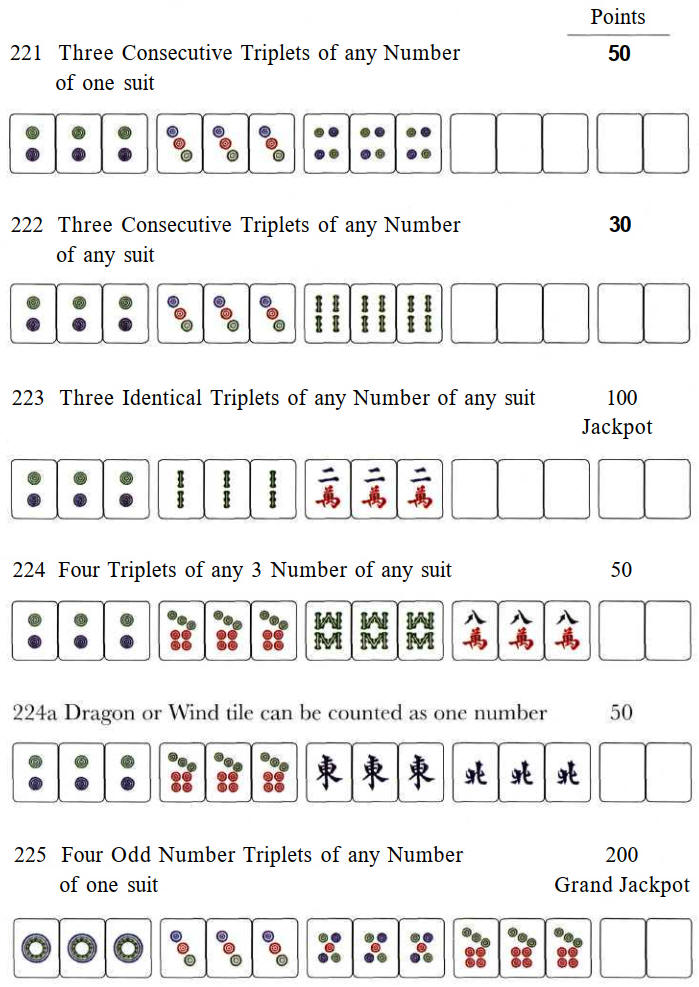
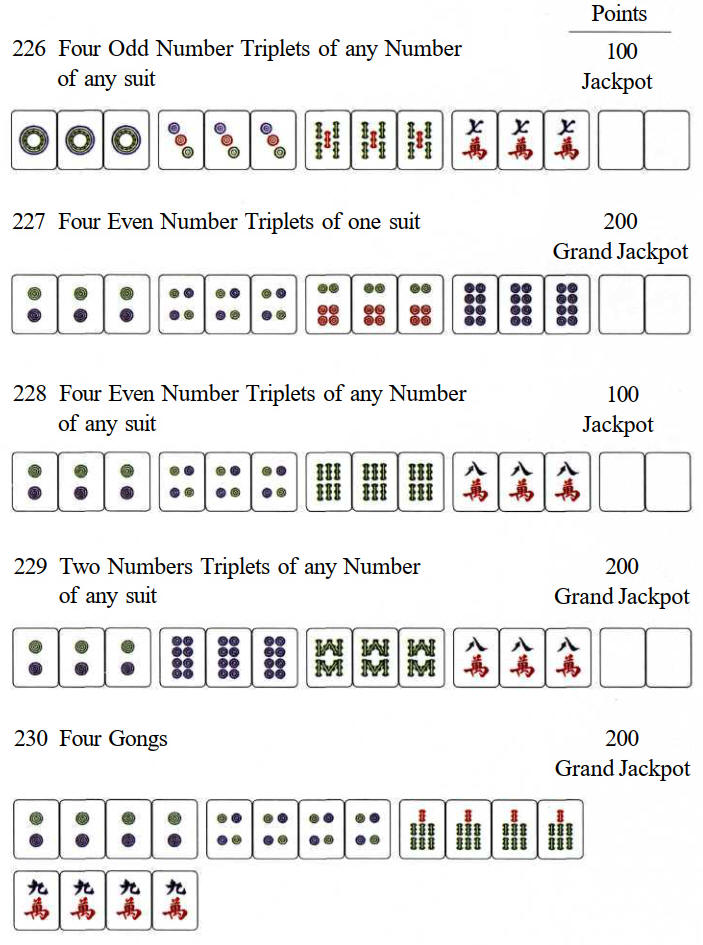
Miscellaneous Combinations

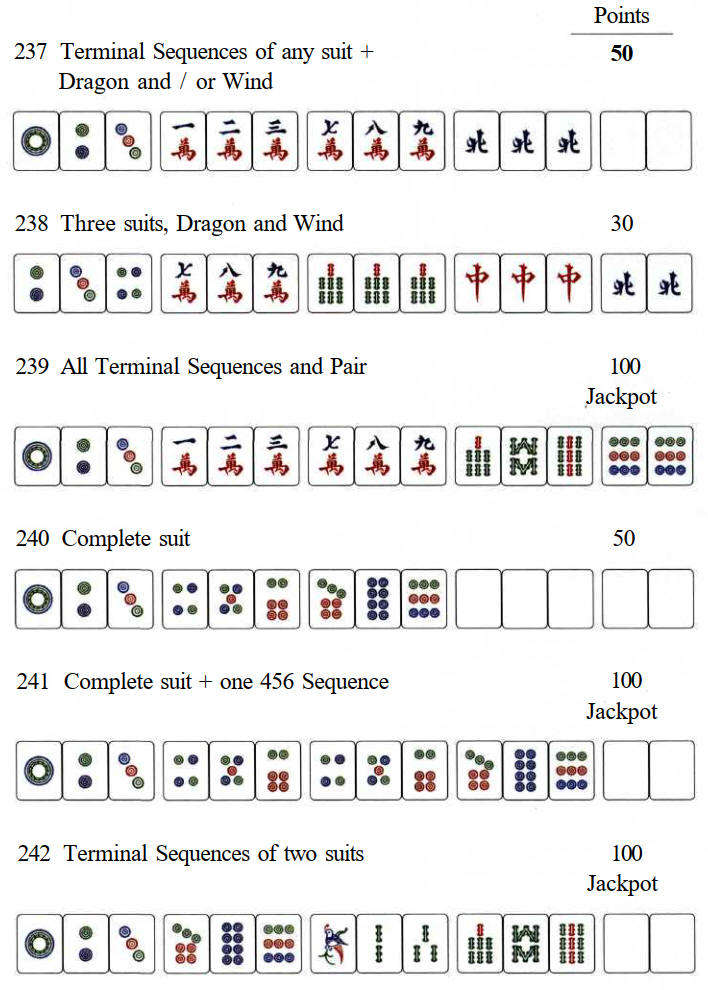

Total Score
The total score of the winning hand is the cumulative winning points in the combination of tiles of the hand.
No extra points will be added to a Grand Jackpot hand.
Sample of winning hand:





